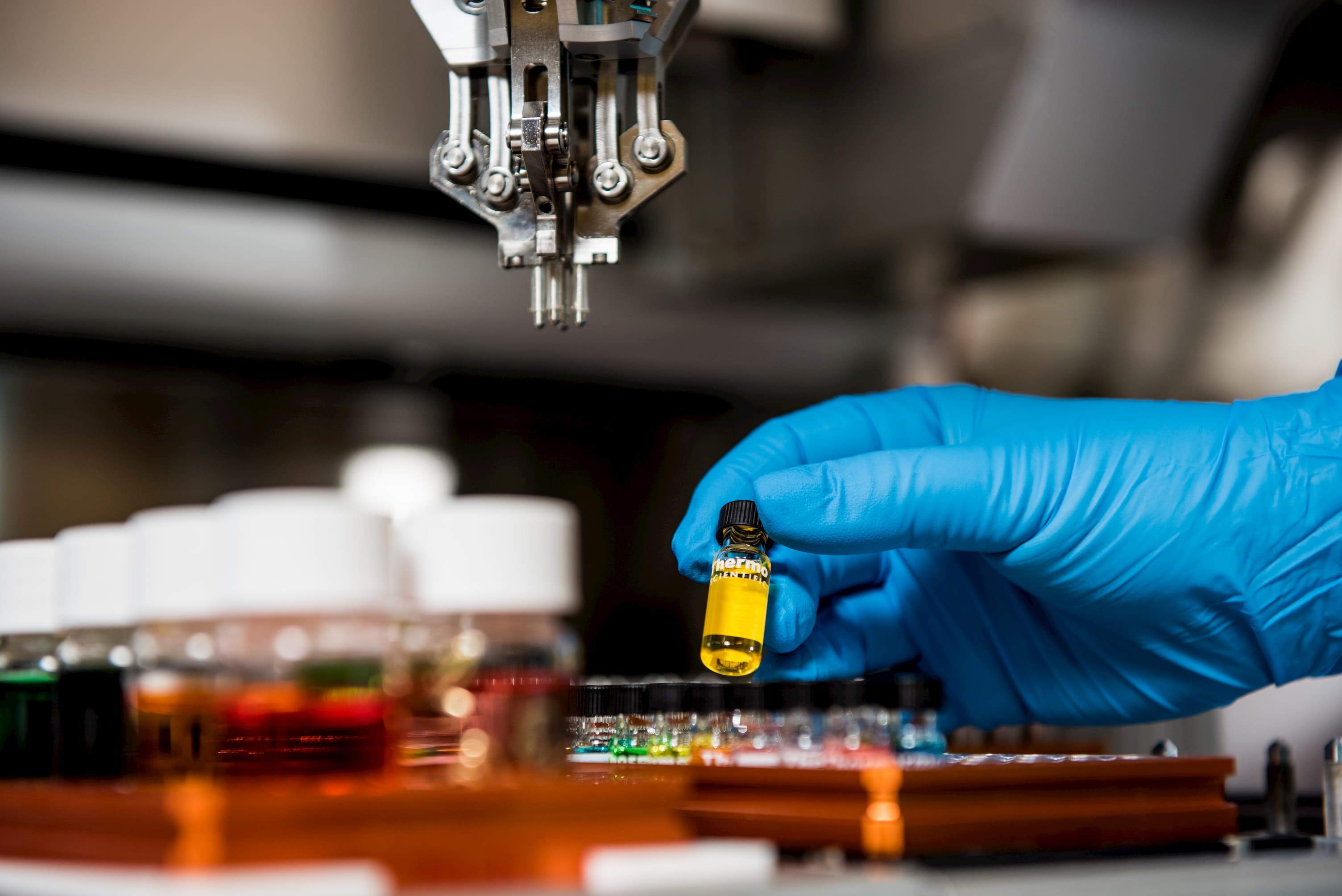
Technology
- 毒性化學物 -
多氯聯苯醚對戴奧辛呋喃分析的影響 Interference of Polychlorinated diphenyl ethers (PCDE) in Polychlorinated dibenzofurans (PCDF)s analysis
多氯聯苯醚對戴奧辛呋喃分析的影響 Interference of Polychlorinated diphenyl ethers (PCDPE) in Polychlorinated dibenzofurans (PCDF)s analysis 陳福冠,黃明豐/正修科技大學環境毒物與新興污染物研究中心 在環檢所的公告戴奧辛呋喃檢測方法「戴奧辛及呋喃檢測方法-同位素標幟稀釋氣相層析/高解析質譜法(NIEA M801.13B)」的七、(四)、3、(6)有提到,確認多氯呋喃(PCDFs)時,相對於待測物滯留時間 ±2秒內,其多氯聯苯醚(PCDPE)不可有訊號強度超過PCDFs的10﹪以上之訊號。本研究的目的為:(1)在觀察三種不同型號的管柱對於PCDPE干擾的分離效果,(2)藉由多沖提一次活性碳管柱來去除PCDPE的干擾,並探討此方法效果。測試使用的管柱型號(廠牌)分別為:DB-5ms(Agilent J&W)、ZB-5ms(Phenomenex)及VF-5ms(Agilent J&W),管柱尺寸皆為60m * 0.25mm * 0.25μm,靜相皆為5% phenylmethyl polysiloxane。測試用的樣本為生物組織混合樣品(代碼:99-TP)及土壤樣本(代碼:C109063008)。檢測流程遵循NIEA M801.13B之前處理原則,經均質、萃取、濃縮、多層矽膠管柱串聯氧化鋁管柱淨化、及活性碳管柱淨化後,以高解析氣相層析/高解析質譜儀分析。
多氯聯苯檢測分析-氣相串聯式質譜儀 Analysis Aroclors Polychlorinated Biphenyls (PCBs)-Triple Quadrupole GC/MS
多氯聯苯檢測分析-氣相串聯式質譜儀 Analysis Aroclors Polychlorinated Biphenyls (PCBs)-Triple Quadrupole GC/MS 李靜宜/正修科技大學環境毒物與新興污染物研究中心 多氯聯苯(polychlorinated biphenyls, PCBs)是由209種的氯化合物所混合而成的,從1930年開始大量並廣泛地被使用於一般工業上,做為電容器及變壓器之絕緣油(用量最多),以及無碳影印紙與塑膠之添加物。經由製造、使用及丟棄的方式進入到空氣、水及土壤中,也會從有害廢棄物處理場被釋放到環境。多氯聯苯分子式為C12H10-nCln(n=1~10),依聯苯結構上氯原子取代數目及位置的不同共有209種同源物(congeners),其氯化程度的不同又區分為10種同族,每一同族物中,依氯原子位置的不同,會有不同數目的同分異構物(isomers)。在美國許多商業用的多氯聯苯混合物是以Aroclor做為商品名稱,依其含氯量多寡作為命名方式,Aroclor系列有1016、1221、1232、1242、1248、1254、1260、1262及1268。 國內目前對於土壤PCBs汙染值法規規範基本上是以Aroclor系列為定量基準。 依照國內環檢所方法NIEA M619中,是以氣相層析電子捕獲偵測器(GC/ECD/ECD)檢測分析土壤中多氯聯苯,使用GC/ECD/ECD主要是因對鹵素化合物有極佳的感度,但因土壤會因汙染來源而含有各種不同鹵素化合物,土壤樣品經由淨化後,仍不易完全去除這些共存的鹵素化合物,這些非多氯聯苯類鹵素化合物也會一起在GC/ECD/ECD圖譜上呈現出來,氯苯及氯酚類化合物,以GC/ECD/ECD分析時會造成判讀上的困擾。若改以氣相層析質譜儀(GC/MS)分析雖有較好的選擇性,但GC/MS對於PCBs的感度遠差於GC/ECD/ECD,且土壤中較難去除的長碳鏈化合物也會造成圖譜的干擾而無法準確判讀。本方法以感度及解析度更好的GC/MS/MS來改善GC/ECD/ECD及GC/MS在分析PCBs上所碰到的困擾,因GC/MS/MS的高感度及解析度在對於去除化學背景干擾有極佳表現。 1.分析方法 土壤樣品以溶劑(正己烷:二氯甲烷1:1),經超音波萃取後,將萃取液以淨化管柱淨化,再將沖提液濃縮上機分析。此次分析利用GC/MS/MS進行檢測,樣品經由離子源離子化後進入第一級四級桿質量過濾器中,所篩選出的母離子會於六級桿碰撞池內進行碎裂,碎裂後的離子會在進行第二級四級桿質量過濾器中進行第二次質量篩選,其篩選出的定量/定性之離子可藉由三軸高能倍增氣電檢檢測器(EM)來進行準確的定性及定量分析。GC/MS/MS為安捷倫系列GC7890A、MS7000A,以1~10氯原子來代表PCBs,其母離子(Precursor ion)/子離子(Product ion)及CE(V)值設定如Table 1.。管柱使用ZB-PAH-EU 30m 0.25mm × 0.20μm,樣品分析前先以M1668A PCBs為時窗標準品,訂出1~10氯PCBs的管柱滯留時窗。 再依M1668A PCBs時窗標準品來建立Aroclor系列1016、1221、1232、1242、1248、1254、及1260標準品之GC/MS/MS標準圖,在此可看出Aroclor系列的TIC MRM上不同氯數的分佈及時窗。將先前以GC/ECD/ECD及GC/MS分析後因干擾而影響判讀的土壤樣品,以GC/MS/MS分析後,可看到未受非多氯聯苯鹵素化合物及長碳鏈化合物干擾的TIC MRM圖。從土壤樣品TIC MRM與Aroclor TIC MRM標準圖比對中可看出土壤樣品7Cl圖A、6Cl圖B、5Cl圖C,分別與Aroclor 1254標準圖(Fig. 7) 7Cl圖A’、6Cl圖B’、5Cl圖C’極為相似;而土壤樣品4Cl圖a、3Cl圖b、2Cl圖c與Aroclor 1242標準圖 4Cl圖a’,3Cl圖b’、 2Cl圖c’極為相似,可精確的判斷出土壤中含有Aroclor 1254及Aroclor 1242二種汙染。 2.結論 當分析土壤內Aroclor PCBs汙染時,相較於NIEA M619方法所使用的GC/ECD/ECD,我們將Aroclor PCBs 應用於GC/MS/MS上,會有更精準的解析度和鑑別度,尤其當汙染是多類型Aroclor時,更顯出GC/MS/MS的定性定量優勢。 參考文獻 排放管道中半揮發性有機物檢測方法-氣相層析/串聯式質譜儀 (NIEA 812)。 審稿者:余建源 組長/正修科技大學環境毒物與新興污染物研究中心
Targeting on Gut Microbiota-Derived Metabolite Trimethylamine to Protect Adult Male Rat Offspring against Hypertension Programmed by Combined Maternal High-Fructose Intake and Dioxin Exposure
Abstract Gut microbiota-dependent metabolites, in particular trimethylamine (TMA), are linked to hypertension. Maternal 2,3,7,8-tetrachlorodibenzo-p-dioxin (TCDD) exposure or consumption of food high in fructose (HFR) can induce hypertension in adult offspring. We examined whether 3,3-maternal dimethyl-1-butanol (DMB, an inhibitor of TMA formation) therapy can protect adult offspring against hypertension arising from combined HFR and TCDD exposure. Pregnant Sprague–Dawley rats received regular chow or chow supplemented with fructose (60% diet by weight) throughout pregnancy and lactation. Additionally, the pregnant dams received TCDD (200 ng/kg BW orally) or a corn oil vehicle on days 14 and 21 of gestation, and days 7 and 14 after birth. Some mother rats received 1% DMB in their drinking water throughout pregnancy and lactation. Six groups of male offspring were studied (n = 8 for each group): regular chow (CV), high-fructose diet (HFR), regular diet+TCDD exposure (CT), HFR+TCDD exposure (HRT), high-fructose diet+DMB treatment (HRD), and HFR+TCDD+DMB treatment (HRTD). Our data showed that TCDD exacerbates HFR-induced elevation of blood pressure in male adult offspring, which was prevented by maternal DMB administration. We observed that different maternal insults induced distinct enterotypes in adult offspring. The beneficial effects of DMB are related to alterations of gut microbiota, the increase in nitric oxide (NO) bioavailability, the balance of the renin-angiotensin system, and antagonization of aryl hydrocarbon receptor (AHR) signaling. Our findings cast new light on the role of early intervention targeting of the gut microbiota-dependent metabolite TMA, which may allow us to prevent the development of hypertension programmed by maternal excessive fructose intake and environmental dioxin exposure.
The impact of pyrolysis temperature on physicochemical properties and pulmonary toxicity of tobacco stem micro-biochar
Abstract Biochars (BCs) are currently widely used, yet their impact on human health is mostly unknown. We generated micro-tobacco stem-pyrolysed BCs (mTBCs) at different pyrolysis temperatures and assessed pulmonary toxicity in normal human lung epithelial BEAS-2B cells. mTBCs generated at 350 °C (mTBC350) and 650 °C (mTBC650) were analysed and compared for physicochemical properties and adverse effects. Pyrolysis temperature had a significant influence on chemical composition, particle size, specific surface area and aromatic carbon structure. mTBC650 displayed a highly ordered aromatic carbon structure with smaller particle size, high surface area (20.09 m2/g) and high polycyclic aromatic hydrocarbon and metal content. This composition could promote reactive oxygen species accumulation accompanied by greater cytotoxicity, genotoxicity and epithelial barrier malfunction in cultured cells. Thus, the risk of pulmonary toxicity owing to micro-BCs (mBCs) is affected by pyrolysis temperature. Long-term exposure to mBCs produced at high temperatures may lead to or exacerbate pulmonary disease.